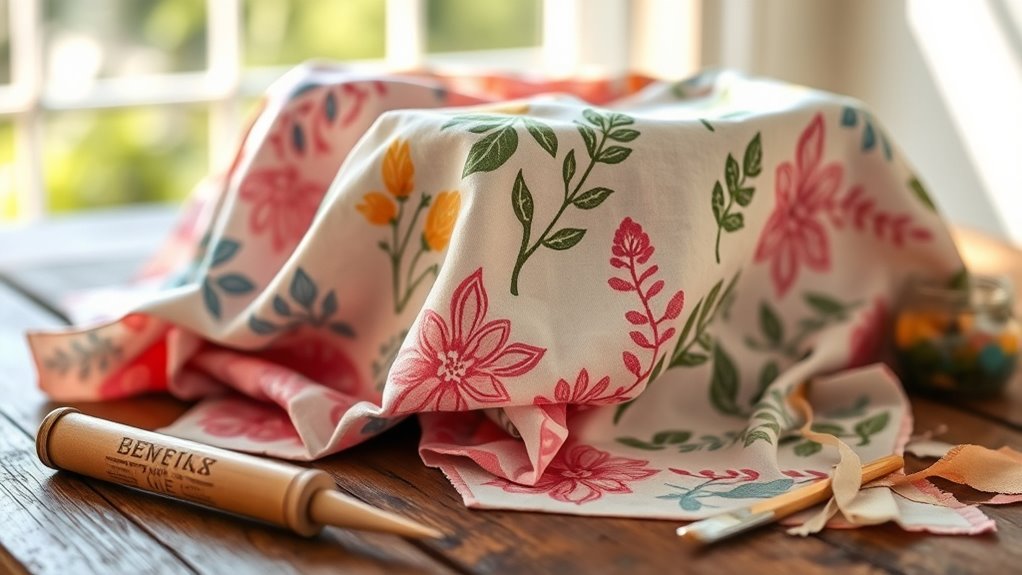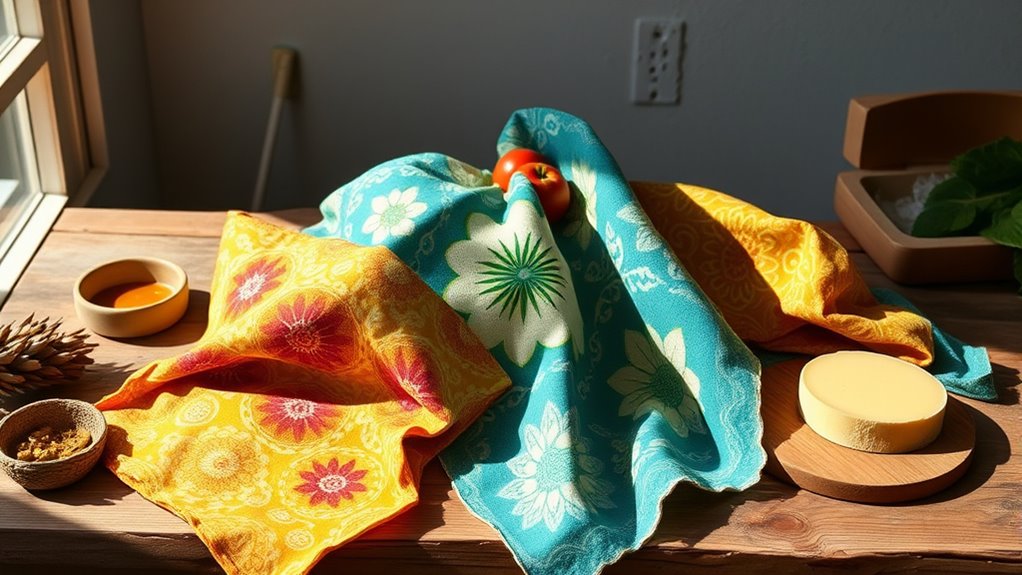Making your own beeswax wraps lets you create eco-friendly, personalized food storage options. Start by choosing sustainable fabrics like cotton or linen, then infuse them with beeswax using a simple melting process. Customize your wraps with patterns or dyes for a stylish touch. Once cooled, test their sealability and reapply beeswax if needed. Keep exploring to discover more tips for crafting durable, attractive wraps that replace plastic in your kitchen.
Key Takeaways
- Choose natural fabrics like cotton or linen and thoroughly wash them before applying beeswax for optimal results.
- Melt beeswax at low temperatures and evenly spread it over fabric using a brush or spreading tool.
- Use an oven or heat source to melt beeswax into the fabric for a flexible, sticky, and reusable wrap.
- Customize your wraps with fabric paints, patterns, or dyes to add a personal and stylish touch.
- Reuse and re-melt wraps as needed, supporting sustainable food storage and reducing plastic waste.

Making your own beeswax wraps is a simple and eco-friendly way to reduce plastic waste in your kitchen. By crafting these reusable wraps, you cut down on single-use plastics while adding a personal touch to your food storage. The first step in creating your DIY beeswax wraps involves understanding beeswax sourcing. You want to find high-quality beeswax, ideally from local or sustainable producers. This ensures your wraps are free from synthetic additives and contaminants, making them safer for your food and better for the environment. You can purchase beeswax pellets, blocks, or pastilles, which melt easily and spread smoothly. Some people even gather beeswax from beekeepers or local apiaries, supporting small businesses and ensuring freshness. Once you’ve secured your beeswax, you can move on to wrap customization, where you truly make your wraps unique.
Start with high-quality, sustainably sourced beeswax to ensure your wraps are safe, eco-friendly, and free from synthetic additives.
Wrap customization allows you to select fabrics that suit your style and kitchen decor. Cotton, hemp, and linen work best because they’re breathable, washable, and durable. You can choose plain, patterned, or even tie-dye fabrics, depending on your taste. Before making the wraps, wash and dry your fabric thoroughly to remove any sizing or chemicals. Then, cut the fabric into your desired sizes—small for fruit or bowls, large for bread or casserole dishes. To customize your wraps further, you can add fabric paints or dye to create personalized designs, giving each wrap a distinct look. Incorporating personalization options can make your food storage both functional and aesthetically pleasing.
Once your fabric is ready, it’s time to infuse it with beeswax. Grate or melt your beeswax, then spread it evenly over the fabric using a paintbrush or a dedicated spreading tool. For a more uniform coat, you can lay the fabric on a baking sheet and sprinkle or brush the beeswax over it. Place the sheet in the oven at a low temperature—around 170°F (77°C)—for a few minutes until the beeswax melts completely. When the beeswax is evenly distributed, remove the fabric and hang or lay it flat to cool. As it cools, the wax will set, creating a flexible, sticky barrier that’s perfect for wrapping food.
With your wraps cooled and hardened, you can test their seal by wrapping around bowls or covering cut produce. If some areas need more beeswax, simply re-melt and reapply. The beauty of creating your own wraps is that you can adjust the beeswax amount and fabric choice to get the perfect seal for your needs. This customization process ensures each wrap performs exactly as you want, making your food storage environmentally friendly, stylish, and uniquely yours.
Frequently Asked Questions
Can DIY Beeswax Wraps Be Reused Indefinitely?
You might wonder if DIY beeswax wraps can be reused forever. While they’re durable with proper care, durability concerns mean they won’t last indefinitely. Over time, the wax can wear down or crack, reducing their effectiveness. Reusing them reduces environmental impact, but eventually, you’ll need to replace them. With good maintenance, you can extend their life, but they’re not truly indefinite. Proper care is key to maximizing reuse and minimizing waste.
What Types of Food Are Safest to Store With Beeswax Wraps?
Think of beeswax wraps as gentle guardians for your food. They’re best for storing dry foods like bread, cheese, fruits, and vegetables, ensuring freshness without contamination. While they’re safe for most produce, avoid wrapping raw meats or oily foods, as these can compromise storage safety and degrade the wraps. Using them correctly keeps your food fresh and your eco-friendly habits sustainable, making every meal a small, positive step.
How Long Do Homemade Beeswax Wraps Typically Last?
Your homemade beeswax wraps usually last about a year with proper care. The wrap lifespan depends on how often you use and wash them, but typically, they maintain good storage durability for 6 to 12 months. To maximize their lifespan, avoid hot water and direct sunlight, and gently clean them with cool water and mild soap. With careful handling, your wraps will serve you well for many months.
Are Beeswax Wraps Suitable for Hot or Microwave Use?
Beeswax wraps aren’t suitable for hot or microwave use because they lack heat resistance and aren’t microwave safe. Exposure to high heat can cause the wax to melt or become damaged, reducing their effectiveness. You should avoid using them in the microwave or with hot foods. Instead, use beeswax wraps for storing cooled or room-temperature items to keep them fresh without risking damage or compromising their eco-friendly benefits.
How Do I Dispose of or Recycle Beeswax Wraps Properly?
When it’s time to dispose of or recycle beeswax wraps, you should consider eco-friendly options. Beeswax wrap disposal usually involves composting if they’re clean and free of food residue. Recycling beeswax wraps isn’t common, but if they’re heavily damaged, check local recycling guidelines. Avoid throwing them in the trash. Instead, repurpose or compost them. Proper disposal helps reduce waste and supports sustainable living, keeping your eco-choices effective and responsible.
Conclusion
By making your own beeswax wraps, you’re not just choosing a sustainable alternative—you’re joining a movement as old as time, echoing the simple, mindful acts of those who cherished the Earth long before us. Just like the bees that tirelessly create their honey, your efforts help nurture a healthier planet. Embrace this small act of kindness, and let it remind you that even the simplest changes can ripple outward, shaping a brighter, greener future for generations to come.








